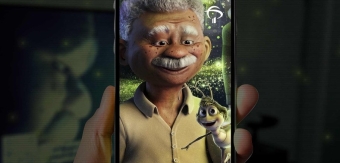Launched in 2011, Chalke Valley is the UK’s leading live history event. For a week every June, over 55,000 visitors, young and old, gather to hear talks, join debates and enjoy immersive experiences that bring history to life.
2024’s relaunch comes as UK festival culture continues to shift from music-only events towards more diverse and inclusive programmes that enrich the crowd’s minds, as well as their senses. It’s a relaunch that required a bold new visual identity and Bloom were more than happy to oblige.
We caught up with the Bloom team this week to learn more about how they captured that unique festival experience.
What was the brief for the rebrand?
Chalke History Festival was at a big crossroads in its 13-year story. There’d been an internal restructure and the organisers wanted a fresh brand to mark a new chapter and period of growth.

Bloom was engaged to collaborate with the founders on a new brand concept and visual identity. To appeal to a broad audience, we needed to reframe history, shedding any outdated or bookish associations. We centred the brand on the belief that bringing the past to life is essential to understanding our present and anticipating our future.
How did the initial pitch/brainstorming phase go?
Chalke gave us a broad mandate to explore what this festival could mean to people of all ages and backgrounds. Bloom aimed to modernise the brand and ensure it worked across both digital and in-person spaces. When we showed Chalke some of our initial thoughts they were excited about its potential.
Describe the purpose of the brand and its target audience
The job of the brand is to reach as many people as possible and explain how history helps us understand our past and present and prepare for the future.

History is a hugely popular pastime in the UK, whether that’s visiting historical sites, watching films or reading books. The brand needed to communicate in a way that appealed to history buffs, families and those who, at first glance, didn’t even realise a history festival could be for them.
What was your thinking behind the rebranding solution?
History is for everyone, and events like Chalke should be accessible to all. Chalke aims to attract a diverse audience of all ages and backgrounds, with varied subject matter and speakers, emphasising inclusivity.
The work needed to hold up when Bloom handed the reins to Chalke. The logo and wider brand elements were made easy to use. This led us to create a bold, distinctive icon that forms the core of the entire identity, influencing the framing of imagery and other creative elements.
What details are you most proud of and why?
The beauty of the approach lies in its simplicity. We transformed a few basic elements into something instantly meaningful and ‘Chalke’. The patterns, colours and shapes can take on different meanings in different situations.

The logo conveys ancient flint tools and arrows, for instance. The dark green and creamy chalk, inspired by the festival’s surroundings, root everything in the location. The design manages to be fun and sophisticated all at once.
What visual influences fuelled your solution?
We looked to the surroundings to define its personality, tone of voice and brand behaviours. Set in the historically rich Wiltshire countryside – all creamy chalks, rural grasslands and stony monuments – the festival immerses visitors in the past while fostering a strong sense of location.
Covering a wide range of topics beyond academia, including politics, sports, food, the arts and current events, we wanted to make the brand curious, sociable, worldly and warm.
What do you hope it achieves for the brand?
Modern relevance and wide reach. Now Chalke is not just about reminiscing, it’s about reigniting curiosity and sparking conversations about where we’ve been and where we’re headed – a compass for the future that looks at today’s hot topics.
How do you ensure consistency in brand messaging and visual identity across various channels and touchpoints?
By keeping it simple so brand owners find it easy to adhere to the guidelines; it’s not necessary to overcomplicate things. Take the logo, inspired by arrowheads – they can be used in multiple ways, including to house photographic imagery and in signage. They also point forwards and backwards, building on key messaging.

We chose the Isidora Sans font for the word marque, echoing classic British poster designs. It all comes together to serve as a foundation for creating memorable and meaningful event assets, from digital content to merchandise, apparel and wayfinding.
How did you ensure that the new brand identity resonated with the brand’s existing audience while also attracting new ones?
The point is this festival is for everyone, young or old, British or visitor, history buff or day-tripper. It’s very much about historical threads and links, and the brand design reflects that. It encourages people to see history as central rather than stuck in the past.
Credit List?
Astrid Kogler - Creative Director
Calum Harbison - Senior Designer
Ed Hayes - Chief Strategy Officer






